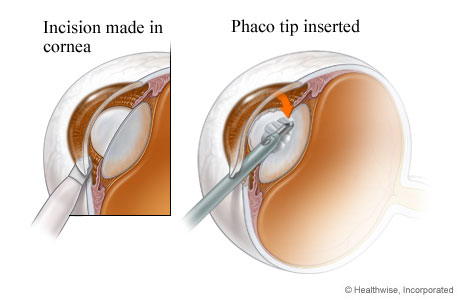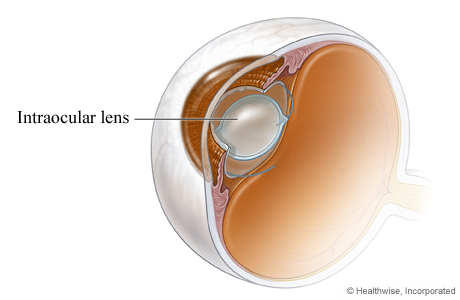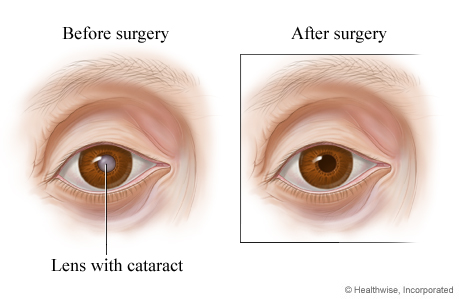Phacoemulsification surgery for cataracts
How a cataract looks

In a normal eye, the lens—which lies behind the pupil—is clear (transparent), so the pupil appears black. In an eye with a severe cataract, the cataract clouds the lens. So the pupil may look gray or cloudy.
Close-up of a cataract

The cornea is the clear layer that covers the front of the eye. The lens is contained inside the eye’s lens capsule. A cataract is a partial or complete cloudiness in the lens.
Incision for surgical instrument is made

Two small cuts (incisions) are made in the eye where the clear front covering of the eye (cornea) meets the white of the eye (sclera). Next, a small, circular opening is made in the front of the lens capsule to allow access to the cataract. A small surgical instrument (phaco probe) is inserted into the eye.
Lens is broken up and removed

The probe uses sound waves (ultrasound) to break the cataract into small pieces. Then the surgeon uses suction to remove the cataract and lens pieces from the eye. The surgeon may use a laser during parts of the surgery.
Intraocular lens (IOL)

A variety of IOL types are available to replace your natural lens. Your doctor can help you choose the type that may work best for you.
A lens replacement (IOL) is inserted

After the cataract is removed, an intraocular lens (IOL) may be placed inside the lens capsule. The back of the lens capsule (posterior capsule) is left inside the eye to keep the clear gel in the back of the eye (vitreous gel), as well as the IOL, in place.
Intraocular lens in place

The intraocular lens (IOL) takes the place of the eye’s natural lens. The incision does not usually require stitches, unless the surgeon decides they are needed.
Before and after cataract surgery

Before cataract surgery, the cloudy lens can be seen through the pupil. After cataract surgery, the pupil appears black because the intraocular lens is clear.
Current as of: May 5, 2019
Author: Healthwise Staff
Medical Review:Kathleen Romito MD – Family Medicine & Adam Husney MD – Family Medicine
This information does not replace the advice of a doctor. Healthwise, Incorporated, disclaims any warranty or liability for your use of this information. Your use of this information means that you agree to the Terms of Use. Learn how we develop our content.

